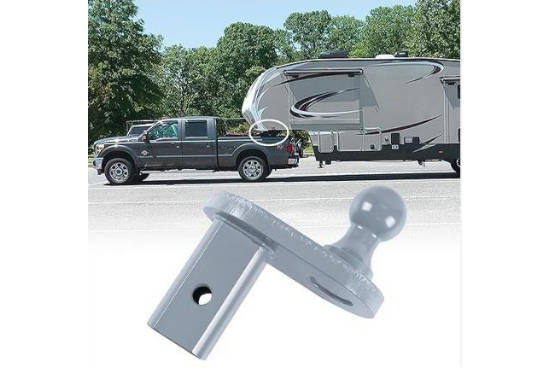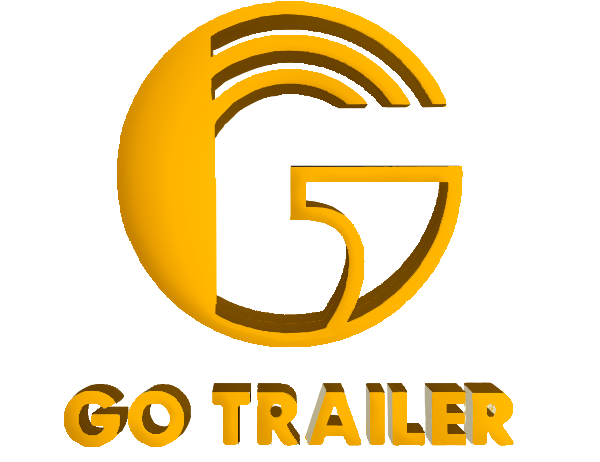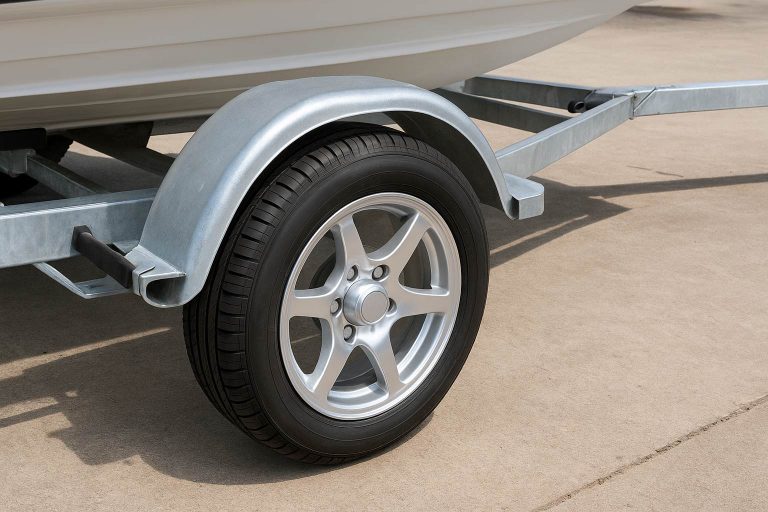To new truck owners just starting to venture into towing equipment, the gooseneck hitch ball kit may seem a little intimidating. But once you realize what you’re getting, how it works, and why you need it, you’ll see why this system is among the most stable and safest means of towing heavy trailers. This article dissects the basics for first-timers and has you up and running before purchasing or installing your first kit.

What is a Gooseneck Hitch Ball Kit?
A gooseneck hitch ball kit is a towing system through which pickup trucks can tow heavily loaded trailers by way of a ball attachment fixed in the middle of the truck bed. Contrary to bumper-pull hitches, which are attached at the truck’s rear, a gooseneck hitch loads the rear axle. This will significantly enhance towing stability, particularly when towing livestock trailers, horse trailers, flatbeds, and heavy RVs.
Truck owners prefer gooseneck systems for:
- Increased weight capacity (typically 30,000 lbs+, depending on your truck).
- Improved trailer sway.
- Narrower turning radius in tight spaces.
Gooseneck hitches are most popular with farmers, contractors, builders, and RV vacationers.
Gooseneck Hitches vs. Bumper-Pull Hitches
Newbies are confused about how to make a decision. Here’s a summary comparison:
| Característica | Cepillo de cuello de cisne | Bumper-Pull Hitch |
|---|---|---|
| Capacidad de peso | Higher | Lower |
| Estabilidad | Excellent | Moderate |
| Maneuvering | Tight turns | Wider swing |
| Mounting Location | Truck bed | Rear bumper |
What’s Included in a Gooseneck Hitch Ball Kit
Hitch Ball
The hitch ball is the main attachment area where the trailer coupler becomes attached. Quality hitch balls are typically forged steel and are either chrome or zinc-plated to prevent corrosion. Standard sizes include 2-5/16 inches, which most heavy-duty trailers use.
Mounting Plate or Under-Bed Bracket
This piece bolts under the truck bed and gives a structural foundation to support heavy loads without sag.
Safety Chain Anchors
Legally mandated in most places, safety chain anchors are an additional attachment in case the primary coupling is lost.
Hardware Set
A complete package will generally contain:
- Bolts.
- Nuts.
- Washers.
- Locking pins (or latch pins).
- Support brackets.
These pieces ensure proper alignment and secure mounting.
Optional Accessories
Some packages or suppliers will add:
- Shim plates.
- Spacer blocks.
- Wear-resistant washers.
- Protective covers.
Accessories serve to minimize friction, prevent truck bed surfaces from being damaged, or facilitate coupling.

How a Gooseneck Hitch System Functions
Truck bed attachment to trailer
The gooseneck hitch system is attached through a bed-holed installation in your pickup truck. The hitch ball is placed directly over or just in front of the rear axle. Through the maneuver of backing your truck under the trailer coupler and letting it drop onto the ball with your jockey wheel, you establish a pivot point that will resist heavy loads but will permit you to take smooth turns. The jockey wheel is also useful for parking a caravan or trailer for many years.
Load distribution and towing stability
Because it’s mounted above the rear axle rather than behind it (like bumper-pull trailers), a gooseneck setup offers better load distribution over your car’s frame. This contributes to a higher towing stability even at high-speed motorway cruising or bumpy road use.
Benefits of Using a Gooseneck Hitch Setup
Increased towing weight
Gooseneck hitches will typically have greater weight ratings than bumper mounts—over 30,000 lbs based on your vehicle design. This makes them perfect to use in commercial or heavy equipment towing.
Improved maneuverability of large trailers
By swinging nearer to the middle line of your vehicle, gooseneck designs offer tighter turning circles compared to conventional hitches—easier to maneuver in confined areas such as building sites or farmyards.
Neater appearance with under-bed mounting
The majority of gooseneck installations employ an under-bed mounting system, such that your truck bed remains open when not in tow mode. Such a neater appearance also permits you to use your entire bed space without hindrance when towing non-trailer cargo.
Installation tips for newbies
Tools to get ready
Before correctly installing your GO Trailer Gooseneck Hitch Ball Kit, get the following tools ready:
- Torque wrench.
- Drill.
- Socket set.
- Measuring tape.
- Safety glasses.
- Protective gloves.
If you’re testing with an electric trailer jockey wheel, ensure access to a 12V power source.
Installation instructions step-by-step
- Metricate and mark where you make your cut into your truck bed.
- Drill pilot holes before cutting with larger bits.
- Install the mounting brackets under the bed.
- Push the hitch ball down through the hole.
- Torque all the bolts with the torque specs outlined.
- Install safety chain anchors.
- Install the coupling to your trailer before traveling.
Why Use a GO Trailer Gooseneck Hitch Ball Kit?
Multiple truck compatibility
Nuestro gooseneck hitch kits are designed to be applicable in a massive array of pickup trucks that are popular in North America, Australia, and Europe. Our clients are largely in the United States, Australia, and Europe, and therefore, we design our products to be globally compatible.

Long-lasting and high-quality material
GO Trailer utilizes high-grade steel powder-coated or galvanized to provide corrosion and abrasion protection. We pride ourselves on being one of the finest manufacturers of trailer parts in China. Our manufacturing line employs the finest CNC machines and laser cutters to supply accurate manufacturing at each phase.
Easy to install and detach
Our kits are pre-assembled wherever possible, so assembly is easy—even for beginners. With or without professional assembly, our systems have user-friendliness as the main objective.
Maintenance and Safety Inspections
Periodic checking of parts
Before each trip:
- Inspect all bolts tight.
- Examine welds on brackets.
- Check safety chains for damage or wear.
- Inspect for no rust on moving parts like pins or latches.
We give customers product use instructions and operational instructions to assist the customer in using and maintaining products more effectively.
Cleaning and lubricating advice
Wash around the hitch ball after every use with mild soap and water; dry and grease the hitch ball, particularly for towing use, to avoid corrosion and friction buildup.
Conclusión
In short, a gooseneck hitch ball kit is the essential accessory for anyone intending to tow heavy trailers effectively and safely. By taking an interest in learning the major components, the installation procedure, and maintenance procedures, newcomers are more apt to make use of the system with confidence. Under proper application, a gooseneck hitch offers greater towing stability, improved load allocation, and more comfortable maneuverability than customary bumper-pull hitches. Selecting a high-quality kit, such as the GO Trailer, guarantees toughness, safety, and long-term reliability for any towing requirement.
FAQ
Q: What trucks are compatible with a gooseneck hitch ball kit?
A: Full-size pickup trucks are mostly compatible, though it’s always best to look at the specifications of the kit. Remolque manufactures kits that have wide global compatibility covering U.S., Australian, and European truck models.
Q: How can I determine the size of the gooseneck hitch ball to install on my trailer?
A: The standard gooseneck hitch ball size is 2-5/16 inches, but always double-check the fit of your trailer coupler.
Q: Do I need to hire a professional to install a gooseneck hitch ball kit?
A: Yes, provided you utilize the correct equipment and exercise proper attention in following torque instructions, you can do it yourself. Professional installation is always advised for new ownership for safety reasons and proper installation.
Q: How should I properly take care of my gooseneck hitch ball to get long-term use out of it?
A: Regularly inspect bolts, welds, and safety chains. Clean out dirt, grease, and greasy components with the proper type, and replace faulty components right away to avoid corrosion or failure.
Q: Why will a gooseneck hitch be safer than a bumper-pull hitch?
A: It mounts above the rear axle, so it’s more evenly balanced in weight, less prone to swaying, and provides better control when towing a heavy load, smoother at high speed on the highway, and on rough terrain.





